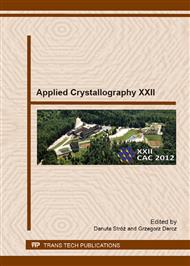p.398
p.402
p.406
p.411
p.417
p.423
p.427
p.431
p.435
Influence of Overheating Temperature on the Shape of Primary Silicon Crystals in Hypereutectic Al-Si Cast Alloys
Abstract:
The paper presents the results of microscopic examinations of the growth of primary silicon crystals in hypereutectic A390.0 (AlSi17Cu5Mg) silumin. A diagram of the growth of primary silicon crystals in the melt without overheating and superheated to a temperature of 920°C has been presented. From the experimental results obtained on crystal morphologies of primary silicon, different sequences of crystal growth of the primary silicon can be expected. In the silumin without overheating, five-pointed star-shaped particles form, after superheating, the crystals of primary silicon take more compact shapes. This structure provides better mechanical properties and thus increases the area of application of alloys with hypereutectic silicon content.
Info:
Periodical:
Pages:
417-422
Citation:
Online since:
June 2013
Authors:
Price:
Сopyright:
© 2013 Trans Tech Publications Ltd. All Rights Reserved
Share:
Citation:


